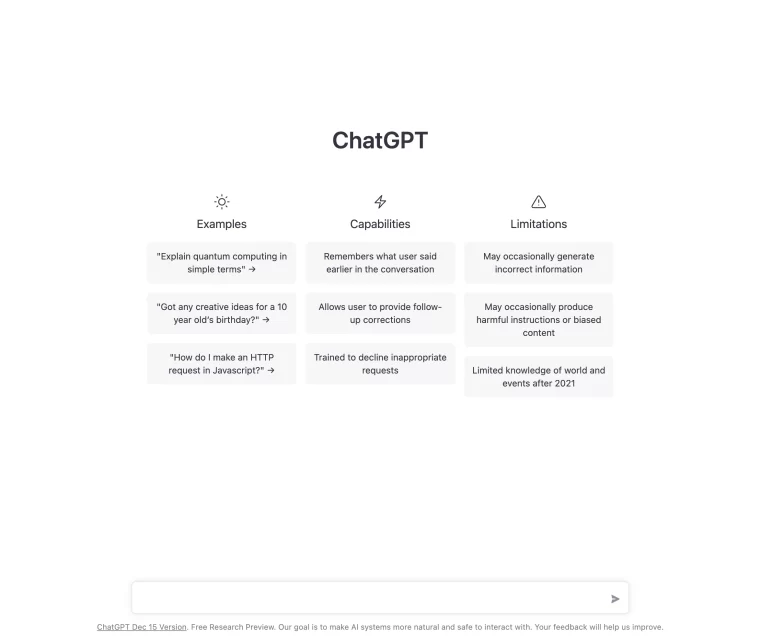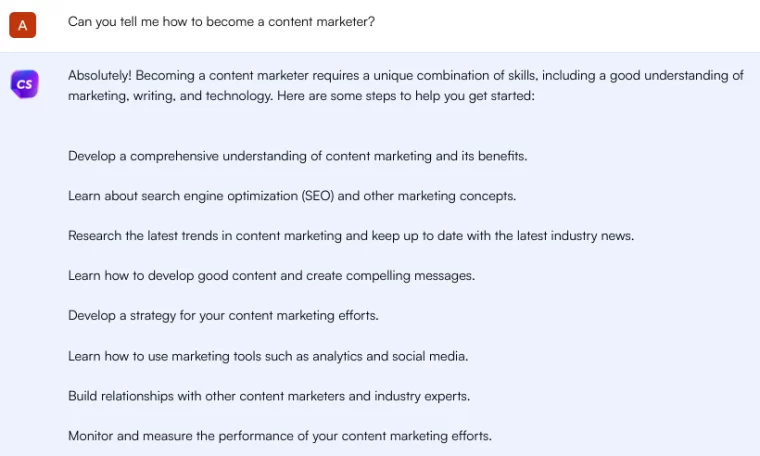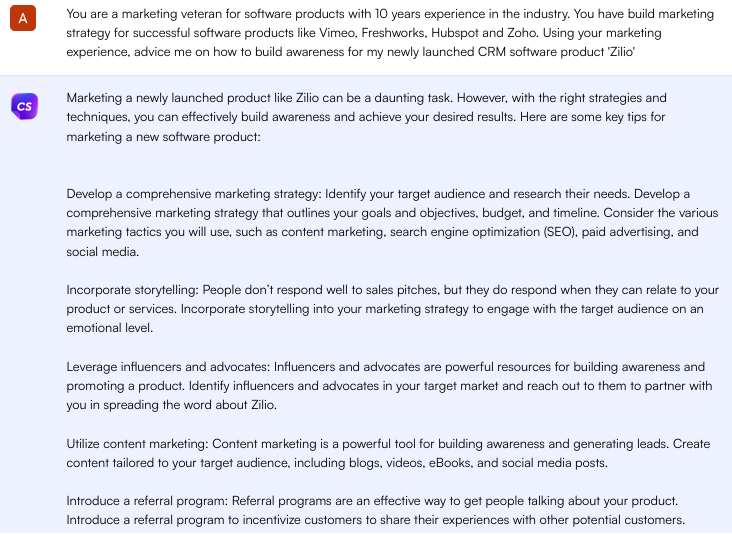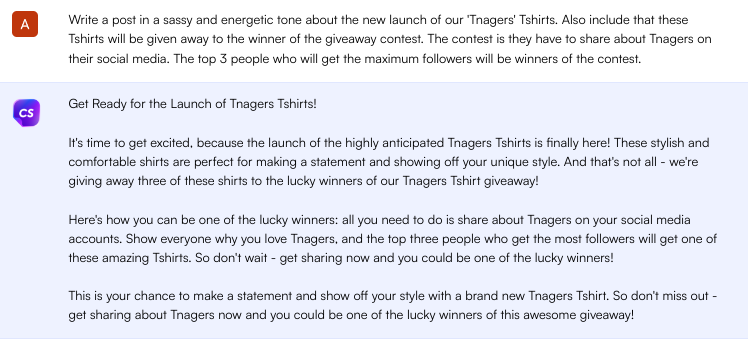How to write ChatGPT prompts: Ultimate guide
Chat GPT is an artificial intelligence that is capable of generating answers to given questions and stimuli. Its full name is Generative Pre-trained Transformer, which is a machine-learned model that is trained on a huge amount of text and is used to generate text in various applications, including chatbots.
When writing prompts for Chat GPT, it’s good to keep a few basic rules in mind. In this article, you’ll find tips to help you write better prompts for Chat GPT.
This is how ChatGPT interface looks like.

What is ChatGPT and how does it work?
ChatGPT is a large language model developed by OpenAI. It stands for “Generative Pre-trained Transformer” and is a variant of the GPT family of models. It was trained on a massive amount of text data, such as books, articles, and websites, and uses this training to generate human-like responses to prompts or questions.
The way ChatGPT works is by using a technique called “transformer architecture.” This involves breaking down text into smaller units, called “tokens,” and analyzing the relationships between them. ChatGPT is pre-trained on a large corpus of text data, meaning it has already learned patterns and relationships between different tokens in language. When a user inputs a prompt or question, ChatGPT uses this pre-trained knowledge to generate a response.

One of the key features of ChatGPT is its ability to generate text that is highly coherent and relevant to the given prompt or question. This is because the model has learned to recognize patterns and relationships between different words and phrases in language, allowing it to generate responses that are both grammatically correct and contextually appropriate.
Overall, ChatGPT is a powerful tool that can be used for a wide range of applications, such as chatbots, language translation, and content creation. Its ability to generate human-like responses has the potential to revolutionize the way we interact with machines and computers.
What can ChatGPT be used for?
ChatGPT’s capacity to comprehend and react to natural language makes it a versatile tool with numerous potential applications. Its applications range widely, and some of the most popular uses of ChatGPT are:
Conversational AI: ChatGPT can be used as a conversational agent to simulate human-like conversations with users, answering their queries, and providing personalized recommendations.
Customer service: ChatGPT can be integrated with customer service platforms to provide round-the-clock assistance to customers, answering their queries and resolving their issues in a timely manner.
Personal assistants: ChatGPT can be used as a personal assistant to manage schedules, make appointments, and perform other tasks based on user input.
Education: ChatGPT can be used to create virtual tutors that can teach and interact with students in a personalized manner, making learning more engaging and effective.
Content creation: ChatGPT can be used to generate content, including articles, blog posts, and social media posts, based on user input and preferences.
Research: ChatGPT can be used to assist researchers in various fields, including natural language processing, machine learning, and social science, by providing insights and generating hypotheses.
Therapy: ChatGPT can be used as a therapeutic tool, providing emotional support and counseling to users who may be struggling with mental health issues.
Entertainment: ChatGPT can be used as a game companion, simulating characters or avatars that can interact with players and provide guidance in games.
All in all, ChatGPT has immense potential for an extensive range of applications, highlighting its adaptability and robustness as a tool. In the upcoming chapters, we will delve into the art of constructing productive ChatGPT prompts that facilitate captivating and informative discussions to serve various objectives.
What is a prompt?
Prompts for ChatGPT are simply the initial text input that you give to the model to generate a response. The prompt can be a question, a statement, a keyword, or any other form of text that you want the model to generate a response for.
For example, if you want to know the weather in your area, you could input the prompt “What’s the weather like today?” ChatGPT would then use its pre-trained knowledge of language to generate a response that is relevant to the prompt. The generated response might be something like “Today, the weather in your area is sunny with a high of 75 degrees.”
Prompts can be as simple or as complex as you like, and the more context you provide, the more accurate and relevant the generated response will be. Additionally, you can provide multiple prompts to ChatGPT in order to generate a longer conversation or a series of related responses.
Overall, prompts are a powerful tool for interacting with ChatGPT and getting the most out of its language generation capabilities.
Why is it important to write better prompts?
Composing precise and succinct prompts offers numerous advantages, contributing to ChatGPT interactions that are captivating and enlightening. The primary advantages encompass:
Better comprehension: Utilizing unambiguous and detailed language aids in guaranteeing that ChatGPT grasps the subject or assignment, generating fitting replies. This can lead to more precise and pertinent responses, enriching the interaction and making it more informative.
Increased concentration: Establishing a well-defined objective and focal point for the discussion helps to steer and maintain its direction. This ensures that the conversation addresses the user’s areas of interest while avoiding digressions or diversions.
Higher productivity: Employing precise and succinct prompts can also boost the conversation’s effectiveness. Concentrating on particular subjects and sidestepping irrelevant diversions guarantees that the conversation remains on course and addresses crucial aspects in a more prompt fashion.
In summary, creating precise and succinct prompts guarantees that ChatGPT interactions are engaging, informative, and effective. In the subsequent sections, we will delve into specific methods for devising powerful prompts that capitalize on these advantages.
Elements of a prompt
Throughout our exploration of various instances and use cases for prompt engineering, you will observe specific elements that constitute a prompt.
A prompt may consist of any of the following elements:
Directive – a particular duty or command you wish the model to execute
Background – may include external data or supplementary context that directs the model toward superior answers
Input Information – refers to the input or inquiry for which we seek a response
Output Signifier – signifies the kind or structure of the output.
The components necessary for a prompt can vary, and the format is contingent on the task in question. We will examine more tangible examples in forthcoming tutorials.
Prompt ChatGPT Step by step
The quality of your prompts for ChatGPT will affect the quality of the result, below we will show you how to write prompts step by step:
Step 1: Define your purpose
The first step in writing prompts for ChatGPT is to define your purpose. What do you want to achieve with the generated response? Are you looking for a specific answer to a question, or are you trying to generate a conversation on a particular topic? Defining your purpose will help you determine the type of prompt you need to write.
Step 2: Determine the topic
Once you have defined your purpose, the next step is to determine the topic. What is the subject matter of the prompt? The topic should be clear and specific, as this will help ChatGPT generate a more accurate response. For example, if you want to know about the weather in your area, your topic would be “weather.”
Step 3: Craft your prompt
The next step is to craft your prompt. Your prompt should be a clear and concise statement or question that is related to the topic. It’s important to keep in mind that ChatGPT generates responses based on the context of the prompt, so it’s important to be specific and provide as much context as possible. Here are some tips for crafting effective prompts:
Be specific: Make sure your prompt is clear and specific. Use specific words and phrases to describe what you’re looking for.
Be concise: Keep your prompt short and to the point. Long prompts can confuse the model and lead to inaccurate responses.
Use proper grammar: Use proper grammar and punctuation in your prompt. This will help Chat GPT generate a more coherent response.
Provide context: Provide as much context as possible to help ChatGPT understand what you’re looking for. This can include things like location, time, and other relevant information.
Step 4: Test and refine
Once you have crafted your prompt, it’s important to test it and refine it as needed. Start by inputting the prompt into ChatGPT and reviewing the generated response. Does the response accurately address the topic and purpose of the prompt? If not, you may need to refine the prompt and try again.
It’s also a good idea to test your prompts with different variations and see how ChatGPT responds. This can help you fine-tune your prompts and get the most accurate and relevant responses possible.
Step 5: Iterate and improve
Finally, it’s important to iterate and improve your prompts over time. As you use Chat GPT more and become more familiar with its capabilities, you may discover new ways to craft effective prompts. Take note of what works well and what doesn’t, and use this knowledge to improve your prompts over time.
Writing effective prompts for ChatGPT requires careful consideration of the purpose, topic, and context of the prompt. By following these steps and refining your prompts over time, you can get the most out of ChatGPT’s powerful language generation capabilities.
Examples of good and bad prompts
Initiating your work with ChatGPT necessitates the accurate crafting of prompts. An effective prompt enhances the tool’s performance and assists you in accomplishing your objectives. Consequently, we aim to provide examples of both well-constructed and poorly-constructed prompts, offering you a clearer understanding of what to evade.
- “Tell me more about the latest trend in the technology industry.”
- “Describe to me the characteristics of the ideal customer for our service.”
- “What are the positive and negative impacts of social media?”
- “Tell me more about everything.”
- “Describe all the characteristics of the ideal customer for our service.”
- “What are the positive and negative impacts of everything?”
Keep in mind that ChatGPT’s effectiveness hinges on the quality of your prompts. Vague or overly broad prompts hinder the tool from delivering valuable outcomes. As a result, it is crucial to pose explicit inquiries or assign distinct tasks, while being concise with your text. Refrain from redundant repetitions or duplicating directives. By adhering to these guidelines and thoughtfully crafting your instructions, ChatGPT can assist you in obtaining top-notch results!
Most common mistakes when writing prompt
- Not being specific enough
- Using complex or unclear language
- Using improper grammar and punctuation
- Failing to provide enough context
- Using biased or leading language
Not being specific enough
One of the most common mistakes when writing prompts is not being specific enough. Vague or general prompts can confuse ChatGPT and lead to inaccurate responses. It's important to use specific words and phrases to describe what you're looking for and provide as much context as possible.
Using complex or unclear language
Another common mistake when writing prompts is using complex or unclear language. Prompts that are difficult to understand can lead to inaccurate responses. It's important to use clear and concise language that is easy for ChatGPT to understand.
Using improper grammar and punctuation
Improper grammar and punctuation can also lead to inaccurate responses. It's important to use proper grammar and punctuation in your prompts to ensure that ChatGPT understands what you're looking for. Use tools such as grammar checkers or proofreading software to help ensure your prompts are grammatically correct.
Failing to provide enough context
Another common mistake is failing to provide enough context. ChatGPT needs context to understand the meaning behind the prompt and generate an accurate response. It's important to provide as much context as possible, such as location, time, or other relevant information.
Using biased or leading language
Using biased or leading language can also lead to inaccurate responses. Prompts that contain bias or lead the model in a certain direction can lead to biased or inaccurate responses. It's important to use neutral language that does not lead the model in a certain direction.
Writing effective prompts requires specific language, proper grammar and punctuation, and sufficient context. It’s also important to use clear and neutral language that does not bias or lead the model in a certain direction. By avoiding these common mistakes, you can ensure that your prompts generate the most accurate and relevant responses possible from ChatGPT.
Examples of successful ChatGPT prompts
In this section, we will examine actual instances of effective ChatGPT prompts employed to accomplish particular objectives. These examples will demonstrate the manner in which well-defined, succinct prompts can steer ChatGPT interactions towards meaningful paths and attain targeted results.
Example 1:

In this example, the ChatGPT is being used as a travel guide, providing suggestions for places to visit based on specific locations and types of places. The prompt is specific and targeted, clearly outlining the role of the ChatGPT and the expectations for the conversation. The use of the “act as” hack and the inclusion of specific instructions for how to communicate with the ChatGPT helps to provide clear direction and guidance.
Example 2:

In this example, the ChatGPT is being used as a plagiarism checker, providing the results of plagiarism checks for specific sentences. The prompt is specific and targeted, clearly outlining the role of the ChatGPT and the expectations for the conversation. The use of the “act as” hack and the inclusion of specific instructions for how to communicate with the ChatGPT helps to provide clear direction and guidance.
Example 3:

In this example, the ChatGPT is being used as a text-based excel sheet, providing the results of specific formulas and commands. The prompt is specific and targeted, clearly outlining the role of the ChatGPT and the expectations for the conversation. The use of specific instructions for how to communicate with the ChatGPT helps to provide clear direction and guidance.
4 tips for better prompts
Crafting ChatGPT prompts is not challenging; however, devising impeccable ChatGPT prompts that yield pertinent outcomes from the language model isn’t a breeze either.
Having employed various AI tools, including ChatGPT, our AI model training specialists have compiled a set of recommendations to help you utilize ChatGPT efficiently.
1. Start with an action word
If you want AI to treat your request earnestly, begin your ChatGPT prompt with action verbs such as Create, Write, Make, or Generate, rather than initiating with “Can you.”
Here’s a brief comparison between using “Can you” and “Create”:
ChatGPT Prompt without action words

ChatGPT Prompt with action words

See the difference! The first response is very generic and does not have any action steps. Whereas ChatGPT, gave a step-by-step detailed, and actionable guide to becoming a content marketer.
2. Use role play
You can ask ChatGPT to role-play. For example, you are seeking content marketing advice on improving brand awareness for your newly launched CRM software.
Role-play ChatGPT Prompt: You are a marketing veteran for software products with ten years of experience in the industry. You have built marketing strategies for successful software products like Vimeo, Freshworks, Hubspot, and Zoho. Using your marketing experience, advise me on how to build awareness for my newly launched CRM software product ‘Zilio’

3. Include the length of the response
ChatGPT does not know if you want a crisp two lines response or a comprehensive paragraph for your prompt. It would come up with its response length if not mentioned in the prompt. To avoid confusion and regenerations, it is good to specify the response length in the prompt.
Another best use case is asking ChatGPT to elaborate or shorten the text.
Using length of response in ChatGPT prompt

4. Specify the tone
If you are using ChatGPT to write an email or a funny meme, specifying the tone can make a huge difference.
For example, you have a young audience to target and want to share something exciting with your community.
Tone-specific ChatGPT Prompt

Troubleshooting
Potential problems that might surface when utilizing ChatGPT
While using ChatGPT, you may come across several typical difficulties, such as:
ChatGPT fails to comprehend the prompt or offers irrelevant or unsuitable replies – This can occur if the prompt is vague, equivocal, or contains technical terms or phrasing unfamiliar to ChatGPT. It might also happen if ChatGPT is missing crucial context or information to grasp the prompt.
ChatGPT delivers generic or unenlightening responses – This can transpire if the prompt is overly general or open-ended, or if ChatGPT doesn’t possess the required expertise or comprehension of the subject.
ChatGPT disregards instructions or limitations given in the prompt – This can take place if the guidelines or restrictions are ambiguous or conflict with the conversation’s primary objective.
ChatGPT generates repetitive or unrelated answers – This can happen if the prompt offers insufficient direction or if the dialogue lacks a clear trajectory or focus.
To circumvent these issues, it is vital to create distinct, succinct prompts that supply ChatGPT with the necessary context, directives, and constraints. Being cognizant of ChatGPT’s abilities and restrictions, as well as testing and refining your prompts, will ensure their efficacy.
AI detector
what is AI detector and why you should care
Gpt3 vs gpt4
What is the difference between chatGPT 3.5 and 4
is it worth of the money?
Conclusion
Effective communication with ChatGPT heavily relies on well-crafted prompts that are clear and concise. A well-defined prompt not only guides the tool to provide useful and relevant output, but it also ensures ethical and responsible usage of the tool.
Open-ended or ambiguous prompts can lead to unintended or inappropriate responses from ChatGPT. Therefore, it is crucial to avoid such prompts and ask targeted and specific questions to prevent harmful or offensive responses.
Moreover, clear and specific instructions in the prompts promote clarity and understanding in communication. By doing so, well-defined prompts facilitate better communication between people.
Crafting well-defined prompts for ChatGPT is vital for successful and meaningful interactions. By following best practices in this article, we can create effective prompts that enable responsible and ethical usage of the tool.
FAQ
Chat GPT is a powerful language generation tool developed by OpenAI. It is a variant of the GPT family of models and uses transformer architecture to analyze text data and generate human-like responses to prompts or questions. Chat GPT is pre-trained on a massive amount of text data, allowing it to recognize patterns and relationships between different words and phrases in language.
Writing effective prompts for Chat GPT is crucial for generating accurate and relevant responses. Effective prompts should be specific, concise, use proper grammar and punctuation, and provide as much context as possible to help Chat GPT understand what you’re looking for. By writing effective prompts, you can ensure that Chat GPT generates the most accurate and relevant responses possible.
To write effective prompts for Chat GPT, you should define your purpose, determine the topic, craft your prompt using specific words and phrases, use proper grammar and punctuation, and provide as much context as possible. It’s also important to test and refine your prompts over time and iterate and improve them based on what works well and what doesn’t.
Common typing errors to avoid when writing prompts for Chat GPT include spelling errors, punctuation errors, grammatical errors, capitalization errors, and typos. To avoid these errors, it’s important to use spell-checking tools, double-check your prompts for accuracy, and use proper grammar, punctuation, and capitalization.
To ensure that your prompts generate the most accurate and relevant responses from Chat GPT, you should be specific, provide as much context as possible, and test and refine your prompts over time. It’s also important to use Chat GPT in conjunction with other tools and strategies, such as human input and review, to ensure that the generated responses are as accurate and relevant as possible.

